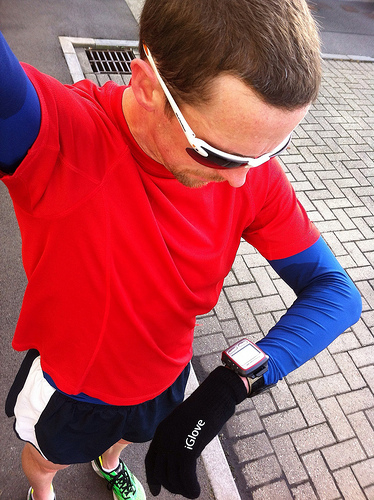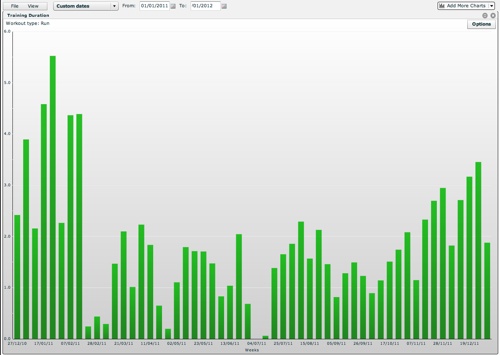
Don’t we always? Keep pushing forward bit by bit and you’ll get there. That’s what I keep telling myself every time I play golf anyway.
But I’m talking about running. I tweaked my left medial gastrocnemius muscle (calf to some of you) at the end of the 2010 season charging up a steep, rocky hill in a cross country aquathlon of all things. It settled down and I had some work done on it, and then I spent much of the winter working on cross country running and my running biomechanics. I was trying to cut down on my heel striking that slowly appeared when I got tired, like towards the end of a triathlon or a half-marathon. It slows me down, so working on that should speed me up, right? Drills and what-nots all worked, but as with many people moving away from a heel strike my calves suffered a greater loading when I ran and needed to strengthen up. I wasn’t jumping directly from a heel strike to a forefoot landing mind you – I’ve been shifting that for the last 7 years or so (with big gaps in running in there).
With the start of the new training season in 2011 a big goal was to run faster, so the training plan was to run more. The problem was that running more means less resting between runs. My calves suffered, I had tweaks and tightnesses and twinges, and ran through some of it. I had work done, we sussed out the problems. I did strength and conditioning work, stretching, and paid attention to my calves, but nonetheless racing often proved too much of a stress and tweaks and minor tears giving super-tight-tightness of my calves returned often. I missed weeks of running to repair and recover, I cut my running load, and I missed a race. My running wasn’t in good shape, but as part of a triathlon it was good enough to keep me in the standings.
Late in the summer after fairly significant damage to my flexor hallucis longus and flexor digitorum longus muscles in my right calf (and possibly others) I reassessed what I was doing. I sat down (good start), thought about the problem and its causes (good idea) and the possible solutions (getting sensible).
The new plan was to aim to run three times a week every week until Christmas, to perform daily stretches of not just the calf muscles but also hip muscles and my lower back, and to start a daily strengthening routine using Alfredson’s heel drops off a step to strengthen the muscle-tendon complex.
The aim of running three times a week over a period of 5-6 months was for a couple of reasons. Consistency builds fitness, and in my case I needed to build the fitness (i.e. strength, aerobic endurance, fatigue resistance) of the weakest links of my running muscle chain. Aiming to run every week for a long period meant I couldn’t injure myself. If I damaged a muscle I wouldn’t be able to run and I would fail. So just running for 20 minutes for 3 times a week would count. If I felt a tweak or a tightness or a pain, I could stop and walk home. That run still counted and I would be able to run again in a couple of days. If I kept trying to hit longer run targets I would probably damage something and fail to run again that week. Fail. It forced me to be sensible.
So getting three runs a week in felt like a success. Repeating this week after week felt like a success. It also made me cut my mileage right back to a very low level. I stopped running first thing in the morning and started running later in the day when my muscles and tendons had warmed up and lengthened a bit.
Slowly, the volume increased. Very slowly. To start with I’d feel the tightness in my calves within 15 minutes, so a 20 minute limit was the maximum I would run. Then on some runs the tightness would only come on a little later. Then I could start to extend the run. Slowly I became able to run for 30-40 minutes with little tightness. Then no tightness at all. My achilles tendons were also sore, but the soreness would kick in at the start of the run and then the scratchiness would die away, and some soreness would only return later.
I added weight to my body weight for the heel drops and that seemed to kick off significant improvements. In the gym I’d hold a 10kg weight and then weeks later a 15kg weight. At home I had a rucksack with weights in it. I made sure to stretch troublesome muscles (calves, hips) some time before a run, let them settle down and then run. I found that stretching my lower back with rotational stretches seemed to help. Focusing on running tall, keeping my pelvis forward, keeping my pelvis level (particularly when tiring) and pushing with my hamstring muscles all seemed to help my running in terms of less pain and soreness during runs.
One of my long term problems is my left hip abductors tiring and allowing the right side of my pelvis to drop, causing over pronation of my right foot and added stress to the tibialis posterior muscle and others. Adding a variant of a single leg squat exercise with weights in the gym helped strengthen up both sides. This squat is done with one foot on a box, squatting to lower the other foot to touch the floor, and then standing up again with the foot on the box. In this movement the pelvis tilts and the leg on the box uses the hip abductors to drop and raise the other leg. These were the muscles I needed to target and this strengthening occurred fairly rapidly over a few weeks. In a normal single leg squat you keep the pelvis level. I’ve used other exercises in the past but this one, probably with its ability to add load by putting a barbell across the shoulders, has made a bigger difference to my hip abductor strength than the others. I’ve been doing single leg squats, clams and the like for years, but they didn’t work as well as this.

Take a look at the table above to see how my running volume per week changed through 2011. It started high and then dropped to nothing as I injured myself. It bounced back and died a couple of times and then I slowly, consistently, patiently built it back up to beyond 3 hours per week without pain. It’s not a huge volume, but it’s pain free.
Eventually I got to the point where I could run for an hour. Whoop! This took months, and by now I was running in dark, wet evenings, but running small hills seems to help. I added hill specific sessions to help strengthen my running muscles. Now, in January and in the third block of training for the 2012 season I’m running for over an hour at a time, I’ve added plyometric box jumps back into my gym work, I have no pain in my calves or tendons when running (and that feels freaking fantastic) and I did my first mile reps at a lactate threshold pace this morning with no calf tightness or soreness.
I feel fairly robust and healthy at the moment. Running has become easy and fun again, and hopefully I’ll be faster this year. I think I’ve learnt that no level of fitness matters if you injure yourself.
Comments
One response to “I got there in the end”
Greetings! Very useful advice within this post! It is the little changes that produce the most significant changes.
Many thanks for sharing!